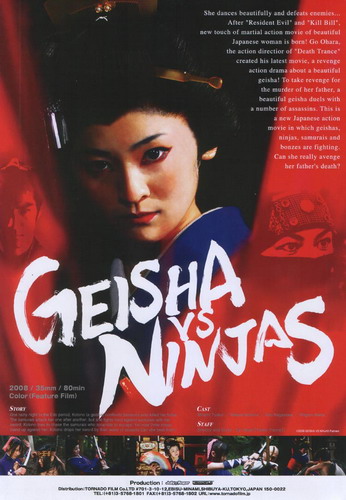he film has been decried by some viewers because the feats of strength attributed to a mere girl are impossible, particularly after she has been injured. That would put down thousands of action films in which the main character is a man, too.
The film is declared a fake, because the script has the heroine fighting a number of opponents in succession – count them: 2 Ronin, 4 Ninjas, 1 Monk, 1 Assassin, 1 Priest, 4 Demons, 1 Samurai, 1 Young Ronin = 15. The same happens in most action films, and if it does not, then it’s because they do not have enough money to pay as many expendable characters; in the best action movies the hero or heroine is supposed to kill hundreds or even thousands of opponents, and survive with less physical damage than our Geisha here, and they are usually acclaimed just for that.
The ninja style bout is a bore, with fake action like jumping to the sky, sliding ten meters over an uneven ground, and so on. True, but that would be inescapable due to the fact the film is an Eastern, and with Ninja in the title. According to the film genre, such scenes are mandatory, though lacking credibility in a rational analysis. The same happens with American or European Westerns in which the colts fire dozens of deadly bullets without being re-charged… and most get good reviews.
The Geisha fights a Monk who is larger and stronger, and she defeated him by her strength, which is another fake. This blame is not true. The Geisha shows stamina equal to the taller, stronger enemy, and defeats him with a clever and unexpected wrestling hold, a figure-four headlock applied with her thighs – the most powerful limbs in an athletic woman wrestler – and takes his breath, and almost breaks his neck with it. Then, as he his still unable to defend himself, she finishes him with a karate punch to the Adam’s apple. (I find this quite believable. Kids of all ages: please do not try this blow at home!)
The film is a chanbara, and one should appreciate the music of the tinkling blades together, and the contrast they establish with the opening soft music in a temple where the grown-up Geisha is dancing – a choreography that she had perfecting as a child, even against the will of her beloved father…
Are Western reviewers so much into computers that they became incapable of understanding a story told as a fairytale about a girl’s quest for her father’s killer, and her family’s sword?
I’m not so much in love with this film to the point of rating it 10, but I understand the people who did that. Very nice cinematography and eventually a better film than what we’re seeing editing down to 78m32s and without a good translation. I saw it in a language I do not speak, and even so I liked it, and got the main points of the story. That speaks high of Go Ohara, the director and screenplay writer.

